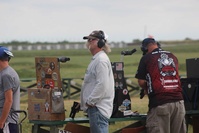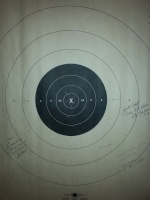Slow fire "double-taps"
+2
STEVE SAMELAK
KelseyECS
6 posters
Page 1 of 1
 Slow fire "double-taps"
Slow fire "double-taps"
I'm returning to bullseye and have been experimenting with a slow-fire technique that was useful for me in the past; slow-fire "double-taps". A couple of competitors in my club have experimented with it in the past, but I think that I'm the only one who has stuck with it. I'd be interested to hear if anyone else has any thoughts on this approach.
By "double-taps" I mean firing a pair of shots in something a bit slower than timed-fire cadence rather than firing a single shot with each lift. My approach is to abort the second shot if it simply doesn't feel right (in the same way that I'd abort a first shot if it didn't feel right). I never fire a third shot.
I do so because I found when I was exercising good follow through in slow-fire to include allowing the dot to return to the bullseye (I visualize that I am guiding the shot to the X-ring when doing so) the pistol would usually settle into a good stable hold. Often it was a more stable hold than my first shot. Thus it occurred to me, why not take that shot.
I have tracked my slow-fire scores when firing single shots vs. allowing myself to take that second shot. My scores are somewhat significantly better when firing in "double-taps". I also have some limited data of having someone else scope both my first and second shot; and the second shot is usually my better shot.
To date I've only experimented with this in 22 (HS Victor and Walther GSP) and 32 (Walther GSP), but I see no reason why it wouldn't apply to the 45 phase as well.
I'd be interested in hearing what thoughts others may have on this technique.
By "double-taps" I mean firing a pair of shots in something a bit slower than timed-fire cadence rather than firing a single shot with each lift. My approach is to abort the second shot if it simply doesn't feel right (in the same way that I'd abort a first shot if it didn't feel right). I never fire a third shot.
I do so because I found when I was exercising good follow through in slow-fire to include allowing the dot to return to the bullseye (I visualize that I am guiding the shot to the X-ring when doing so) the pistol would usually settle into a good stable hold. Often it was a more stable hold than my first shot. Thus it occurred to me, why not take that shot.
I have tracked my slow-fire scores when firing single shots vs. allowing myself to take that second shot. My scores are somewhat significantly better when firing in "double-taps". I also have some limited data of having someone else scope both my first and second shot; and the second shot is usually my better shot.
To date I've only experimented with this in 22 (HS Victor and Walther GSP) and 32 (Walther GSP), but I see no reason why it wouldn't apply to the 45 phase as well.
I'd be interested in hearing what thoughts others may have on this technique.
KelseyECS- Posts : 19
Join date : 2015-05-06
Age : 64
Location : Washington state
 Re: Slow fire "double-taps"
Re: Slow fire "double-taps"
If everything is falling in to place, why interrupt the process?

STEVE SAMELAK- Posts : 958
Join date : 2011-06-10
 Re: Slow fire "double-taps"
Re: Slow fire "double-taps"
You are pulling the trigger differently on the first and second shot. I would bet you are holding on target longer on the first shot than you are on the second shot. Most likely the first shot is typical slow fire, holding longer, looking for the perfect sight picture, starting and stopping the trigger pull and the second shot is typical sustained fire, starting the trigger pull as soon as the sights return to the target, accepting a certain amount of wobble and pulling the trigger more smoothly and continuously.
I used 'double taps' to (finally) prove to myself that I had two different trigger pulls. I was trying too hard and interrupting the trigger in slow looking for perfection. I had the same experience as you, the second shot was almost always better than the first.
I used 'double taps' to (finally) prove to myself that I had two different trigger pulls. I was trying too hard and interrupting the trigger in slow looking for perfection. I had the same experience as you, the second shot was almost always better than the first.
 Re: Slow fire "double-taps"
Re: Slow fire "double-taps"
ive seen some do it on occasion but not as a routine but if its working for you then go with it.

DavidR- Admin
- Posts : 3032
Join date : 2011-06-10
Age : 70
Location : NRA:Expert, Georgia
 Re: Slow fire "double-taps"
Re: Slow fire "double-taps"
When I started back shooting, after an 18 year layoff, I learned quickly that I could not shoot slow fire and expect to make it through a match. I made the decision to shoot all slow fire as sustained fire and did for the entire 2014 shooting season. Didn't shoot any exceptional slow fire targets but high 80s and low 90s were routine. Anyone else remember Tom Woods the AMU shooter? First time I shot anywhere close to him I was agast that anyone would shoot slow fire that way. Of course he won the match... =:-)
Axehandle- Posts : 879
Join date : 2013-09-17
Location : Alabama
 Re: Slow fire "double-taps"
Re: Slow fire "double-taps"
Tom Woods trained shooting sustained fire for SF to train for Perry's wind. He won the same year. He continued to shoot that way afterwards.
Jon
Jon

Jon Eulette- Posts : 4399
Join date : 2013-04-15
Location : Southern Kalifornia
 Re: Slow fire "double-taps"
Re: Slow fire "double-taps"
The observation that scoring better on the second shot of a slow-fire "double-tap" may indicate that one is holding too long for the first shot is interesting. It's certainly something worth watching for in my next few practices. It would seem that one would hit the most stable point of their hold just as quickly on the first shot as the second; but it is undeniably true that I take longer to release that first shot.
Something else worth doing, just for yuks; take all of the timed-fire targets and overlay them on a slow-fire target to see how it would have scored. An interesting way to see if you would be better off firing slow-fire as a timed-fire string. (I don't think that this will be true in my case, but I wonder how they'll compare).
Thanks ...
Something else worth doing, just for yuks; take all of the timed-fire targets and overlay them on a slow-fire target to see how it would have scored. An interesting way to see if you would be better off firing slow-fire as a timed-fire string. (I don't think that this will be true in my case, but I wonder how they'll compare).
Thanks ...
KelseyECS- Posts : 19
Join date : 2015-05-06
Age : 64
Location : Washington state
 Re: Slow fire "double-taps"
Re: Slow fire "double-taps"
Look at typical tf and rf groups/scores. 1st shot is normally jardest shot to break snd next 4 shots are excellent. SF is same way for multiple shots. It's because successive shots are easier to keep the trigger moving. Chicken finger is a 1st shot thing. It applies to all yard lines.
Jon
Jon

Jon Eulette- Posts : 4399
Join date : 2013-04-15
Location : Southern Kalifornia
 Similar topics
Similar topics» Training slow fire and rapid fire only
» Slow Fire vs. Timed/Rapid Fire Trigger Pull
» Sustained Fire cadence in Slow Fire
» Slow fire at timed fire pace?
» Slow fire at Timed fire pace
» Slow Fire vs. Timed/Rapid Fire Trigger Pull
» Sustained Fire cadence in Slow Fire
» Slow fire at timed fire pace?
» Slow fire at Timed fire pace
Page 1 of 1
Permissions in this forum:
You cannot reply to topics in this forum